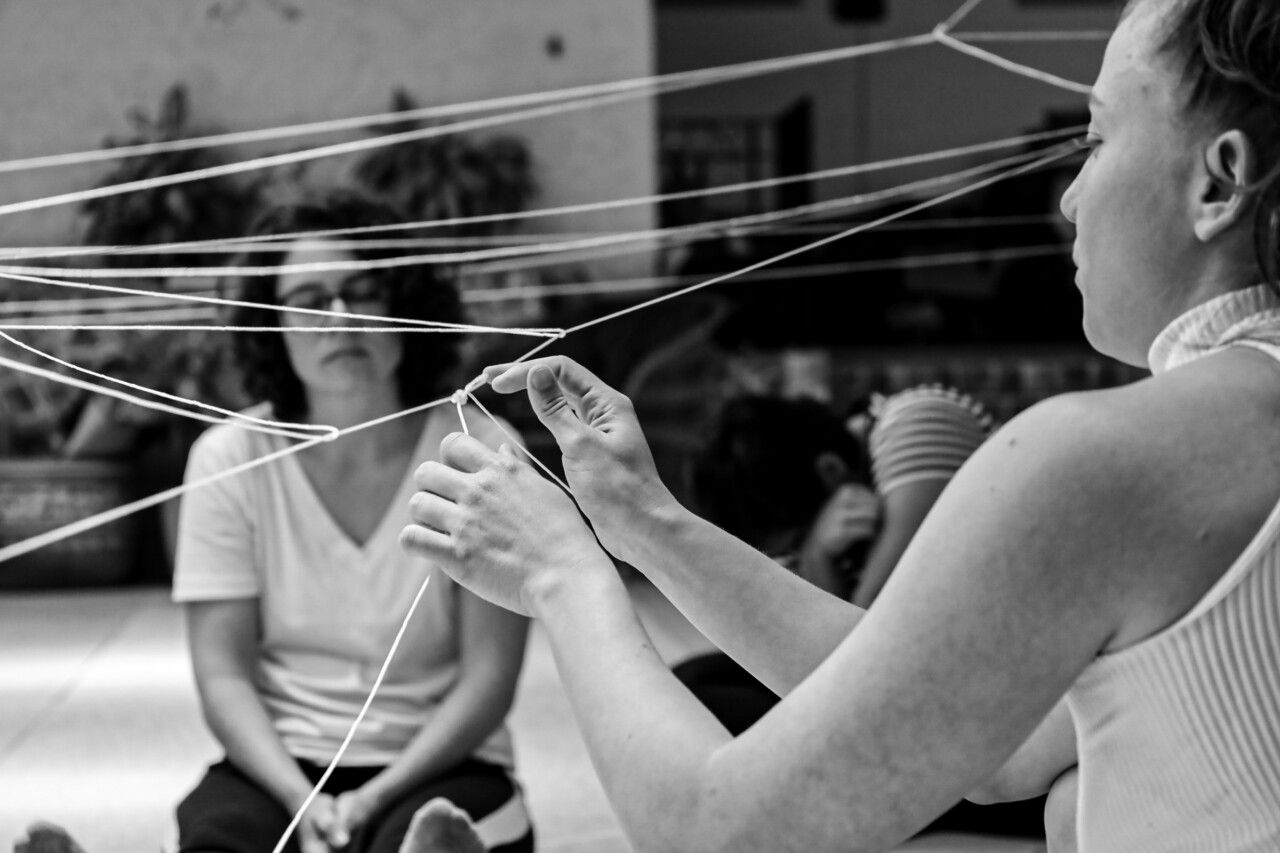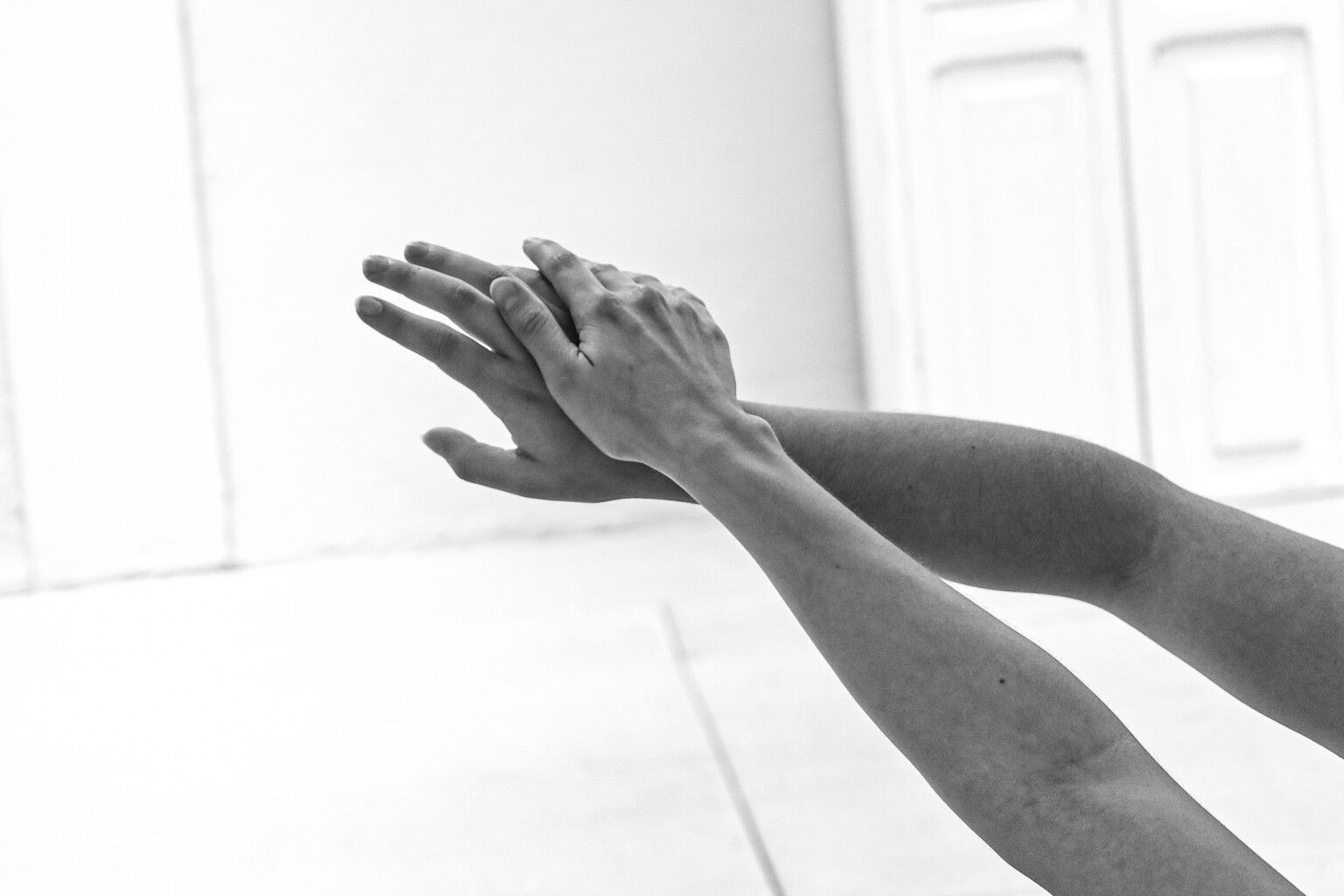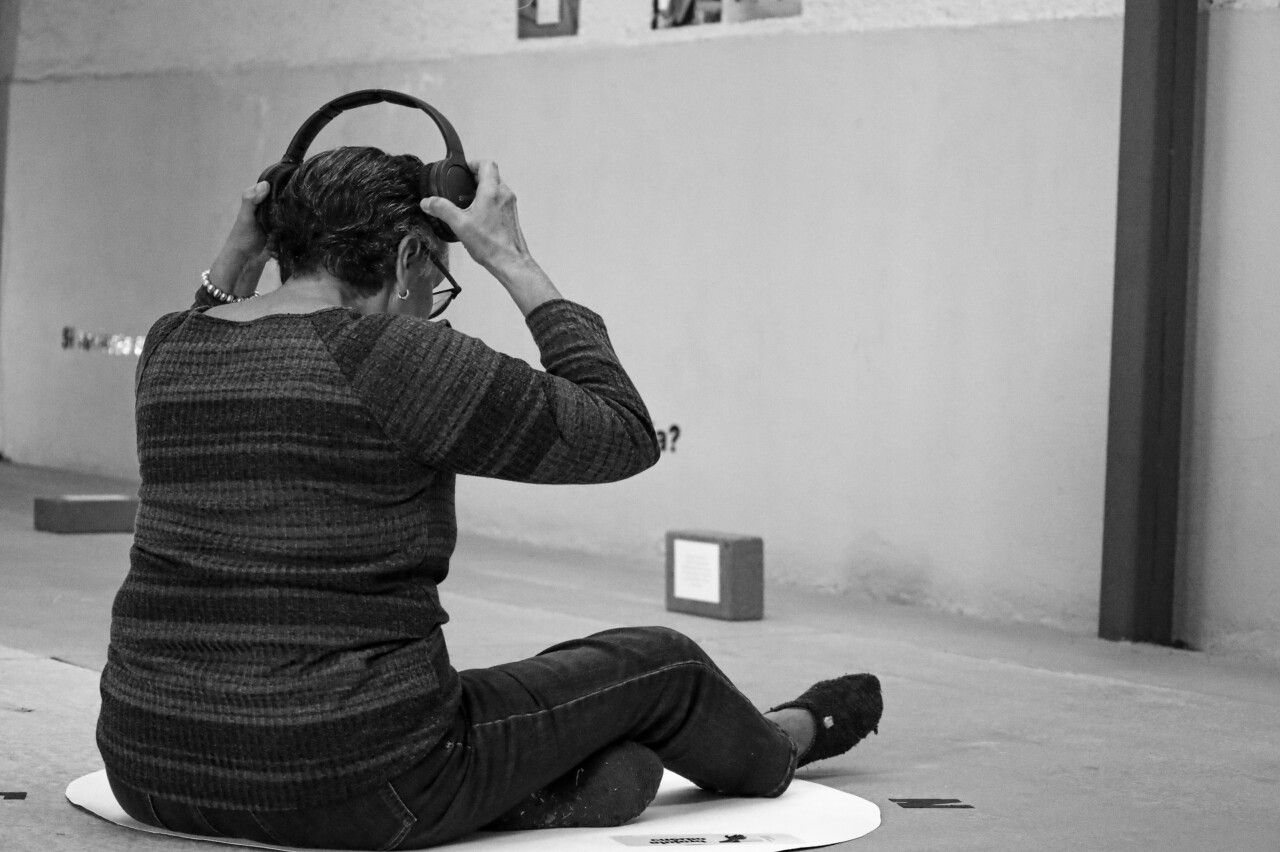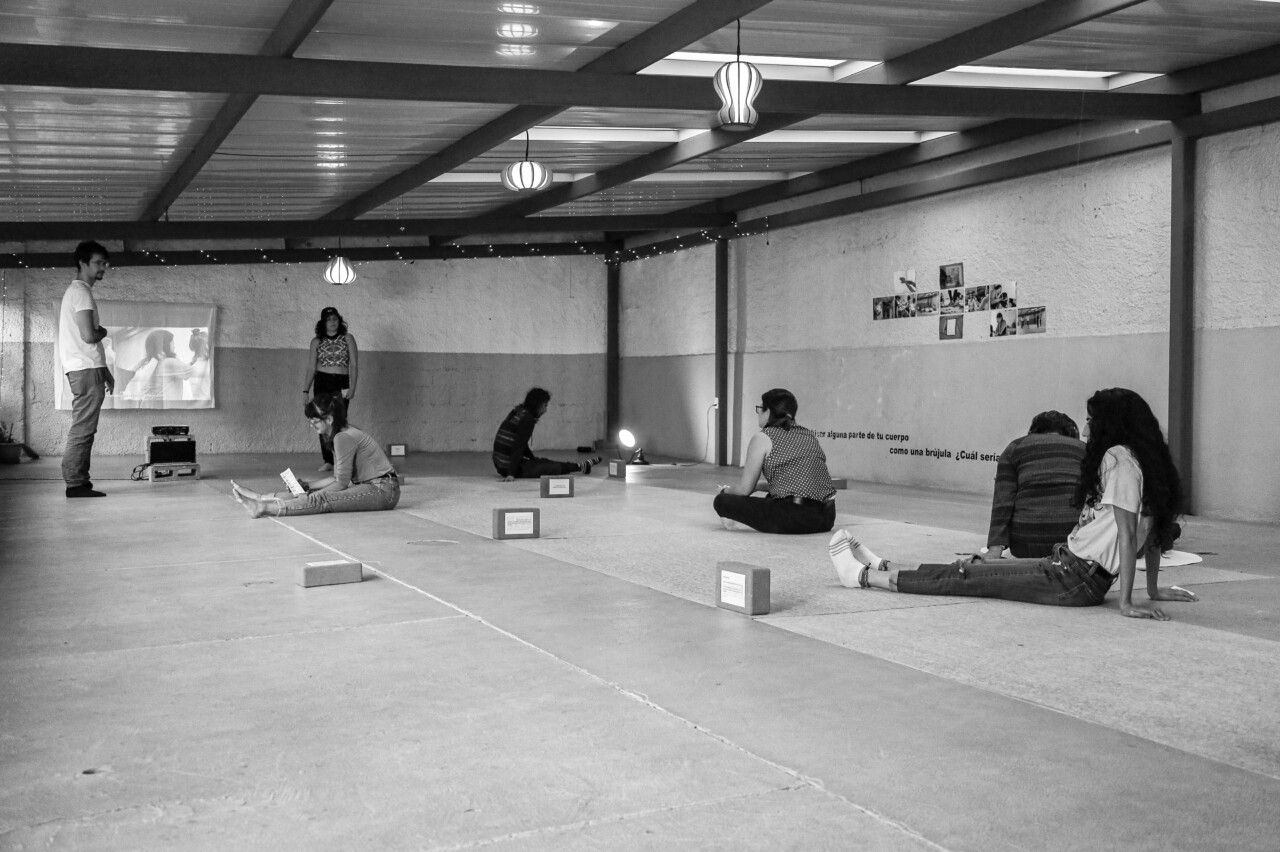COMPASS-BODY

Lab 1 “The wound” register - performed on June 25, 2022 in the Cosmic Guaria. Exercise weaving collective relationships between the words Learning-Perception-Memory. Photo by Natalia Argüello Hernández.
The journey:
Lab #1: (2022, june 25): The wound.
Lab #2: (2022, September 24): The skin.
Lab #3: (2022, October 15): The gaze.
Compass-body Open exhibition: (2023, february 25).
Each Lab lasted 6 hours. In total, we shared 18 hours together with 16 people. In each Lab we produced a shared lunch made by the collective. Each meeting proposed a mix of methodologies in which we alternated between corporal exercises and individual and collective registrations in which the possibilities of creation and articulation of knowledges around the proposed themes and focuses were deployed. The open exhibition that follows the Lab’s was a space where, along with curator Andrea Cambronero, we arranged materials and activations that had emerged from the collective recordings of the labs.
WOUND AND TISSUE: Reflections and registers from the laboratories.
How funny...
When we approach the concept of perception, memory and learning, especially learning... something hurts... and sometimes it hurts so much. Memory feels blurred and perception tends to be confused with perspective. Learning feels far away. The body wounded by the institutionalisation of learning relates the action LEARNING only with linearity, steps to follow, novelty - what I am not and do not know- activity/ productivity/ results and always limiting learning to personal and private experience.
But we are tissue.
LEARNING1: Time Changes Change the way of looking - Do we change the word for another - Constant day by day - How to relieve the daily learning to know my way of learning - What are the daily structures? - Where does the magic of learning lie? - See our needs - Experience body - Presence feeling - You only learn if you are present? - Constant process of travel between the different voices narrating the paths and the elements that one finds in one's own experience. Associated with perception and memory - What if there are no voices?, what emerges along the way?- Transiting and transiting again a space/time with a new meaning - Is learning reused or discarded? What is a new learning? - Who am I today? - What brings us reflections - Is learning mutating or fixed? - Integrity Tenderness Body- How beautiful is tenderness! - How can one learn with tenderness? - How can one learn without it? Going through the body mind, being new knowledge, skills, experiences - Where do you transit to? where do you get to with learning? - I don't know, that scares me - Process, Exchange, Dynamic, Roller coaster, Awakenings - How do I get on that roller coaster? - Skills Tools Game Power - Do you believe in what you know? - Do I know what I believe in? - I believe it is a process - Self-knowledge - Emotions - Is it a risk? - Building relationships. A bag of magic powers - I love it. I also see knowledge and learning as magic, amix? - New neural pathways... through the body - Uncertainties.
And we weave for what we inhabit.
MEMORY3: Something that helps me not to forget - And also helps me to forget? - Experiences, Subconscious, Ancestral heritage, remembrance - Do you believe in your memory? - As much as I believe in my desires, dreams - Experience living - What value do you give to what you have lived - Who tells you what you have lived? - Ability to archive, store, events, concepts, sensations - How reliable is memory? - Re-feeling (feeling again) memories of our body and mind - [here they drew a curvilinear connecting with the following] Body (Skin Mind Heart) + various memories and from all senses. Awakenings - Most valuable memory? - Does memory create? - Memory: that which went through us so much that we decided or not to keep - From where do I give value to keeping? - Sense, Memory, Time - Memories, Knowledge, Trauma and Growth - A collective act with dispositives that allow us to remember or to forget. It has personal, social and political dimensions. It is installed in embodiment. - Can I embrace all my memories - That is my goal right now - Can we conciliate those painful memories? Rearrange them - Experiences -Embrace - [Connected to] Storage - What is stored and what is discarded? - Does it have limits? - Archive Observatory - Why is memory archived? - Can these archives be used to create? - What does this archive look like? - Does it need to be archived to be observed - Does it need to be archived to be observed - Do all memories have words? - Memory and desire? - Can you only keep what you want? - The life I imagined living - Does that imagination come from inside or outside? - Is imagination memory? - Is memory imagination? - When memory is imagination? - Trauma Joy Structuring moments - Where do we put emotions in all this? Could we value them as information and not as positive or negative?

How do you learn? Are there phases? Are there layers?
How does your body enjoy learning the most?
What have you learned with your body?
…
When do you learn?
When you learn which senses do you use more, which ones less? Why?
What do you pay more attention to? Why? What do you pay less attention to? Why?
…
Do you remember what your learning was like when you were a child?
Do you remember how you felt learning?
What learning are you remembering now?
…
And now… Can you remember what you forgot?
Could you observe in your body how it feels to forget?
How do you see or imagine forgetting?
How do you forget?
…
And your memory? How is it?
How do you imagine the architecture of your memory? Is it architecture?
Is it a space... an object... an image... a file... a shape... a sensation... a taste... a texture... a temperature... is it organised... is it chaos... is it compact or is it expansive...?
…
What are you perceiving right now?
What do you think perception is?
How do you imagine the journey from perception to emotion?
From perception to action?
From perception to thought?
How do you perceive?
How complex and broad perception is. After reading Damasio4, it is difficult to put into a few words only how broad this concept is. But we can try to say that: perception is the result of the brain's cartographic skill. And that is precious. We are a body and we inhabit a body. That is to say, the cartography that our brain makes on our body is what we perceive consciously through images (what we think we are), but there is a body that escapes consciousness and it is the body that we inhabit -the body itself-, also mapped and generated by images. But these escape from language. We are because of what we inhabit or rather we are what we inhabit and that -with delicacy, because we know that it is not entirely true- what we inhabit is what we are. There is an interdependence between being and existing. Between the human being and his environment-context-situated knowledge. That emotion is a context, and perception is its first substrate. Perception is defined as the set of processes and activities related to the stimulation that reaches the senses through which we obtain information about our habitat, the actions we perform in it and our own internal states. Perception allows us to form a mental image that is formed with the help of our experiences, needs and emotions. Emotion is a context rather than a concept.5 It is an aesthetic experience. It is an event. Emotion creates contexts in the body. Emotions are therefore methodological dispositives.
PERCEPTION6: I feel, I sense, I identify with the body - Sense - Do you hear your whole body? - [Drawing of circles with arrows] - Go from a small and centered circle to a more distant, wider circle where I can see more details - Do you value your perception or do you look for someone else to agree with you to validate you? - Open your senses to the world, have places to look at the lens, not only at the landscape. Conjugation of information, modifiable quality of being. - What if the answer is also within us? - It goes through the senses and interprets - Recognize/Love - What else are we allowing to recognize? - Perception Multisensoriality Present Openness - Get out of my bubble - How to enrich myself from the contrast with what I reject? - Bodies Senses Stories People - Does my personal history condition my perception? - VALUE - What do we see/perceive? Is the possible allowed? How do we do to perceive more there? And when we return to everyday life, what do we do with what we perceive? The memory of what we perceive and the learning that it can suggest - The wordless zone - Could it also be verbalized? How does perception move? - World view. Experiences - From which perspective, one's own or another's - Both? - How to approach something from the body/mind - Each perception within everyone is a different one - sensitive sensitivity - Do I trust my sensitivity?- If I do not trust it ceases to exist?- How my body/mind/being receives information from the outside based on my subjectivity - Do I believe everything I perceive? - What place does fear have in my perception? - How does fear have in my perception? What place does fear occupy in my perception? From fear comes distrust? - Senses - Is there any sense that I prioritize? - No sense? - Could we trust only what we feel?- Does time really pass as we perceive it? - The pores that also look. They enter through other and plural senses - From what place do we observe ourselves? - Ability to register the environment. Traversed by our ideas, emotions, place in the world in which I am situated - Do we register because we want to or because we must? - How to legitimize perception as a place of certainty and at the same time not place that weight on it?

“The palms of our hands are filled with tiny eyes that look in and out… I perceive that the contact is more intense when I am not touching, and in the middle of this feeling I dismantle the concept of the concrete, of the matter”. Taking from Lab 2 design, The skin. Photo by. Natalia Argüello Hernández.
Learning is first and foremost a bodily process. Learning is an autopoietic7 process, it is a process of doing. Learning is an event. We learn all our lives and at all ages. But in the first years of our life8, during the most sensitive processes9 of our becoming with the world, we are inserted in the institutionalism of learning, which systematically sows in our nervous system the idea of linear and finished learning, of comparative relations and in a state of threat with the exercise of retrieving information from our memory (examination), out of a still body, in silence without integration, interaction and tearing itself away from its otherness, denying its desire. Could it be said that we have lesions in learning? Our memory, perception and learning can be wounded, as much from their concept as from their emotional context and their ways of being-doing? The context besides the emotional is also the imagined and the thought. That is why we like to think,10 to try and explore, to give back to the body what is its own. To pass from the fleshy learning to the embodied learning, in situation and constant affectation. We like to provoke the perception overturned, contradicted, rhizomatic, disordered and expanded, the universe is the space behind the eyes. We like to exercise the imagination as a resemanticiser of past emotional contexts, inscribed in the wound, and remove the memories to bring them back to life.1211
An ____________of orientation.
_________= instrument, object
Guide, amulet, heart
Desire, dream.
It takes me to the north
And, What is the north
When we want to travel to
the South. Correction
It indicates the north
so I can go to the south
What? What is a compass for?
When one's desires are getting lost
What is a map?
And an astrolabe? Sextant
GPS, watch. Constellation. Horizon.
What is a point? Cardinal
Point. Referent point. Meeting point.
What is all this but traveller´s vocabulary?


We like to explore getting lost, because being too located in systematically learned cartographies is suspicious to us. Invoking Solnit, to explore towards-in-with the terra incognita14, that is, to travel outside the map, outside the known territory. We like to explore/provoke the chaotic in the processes of becoming lost and emerging the compass body, that which is in constant loss and recovery of equilibrium. Re-questioning- what locates me, what makes me decide to move and in which direction, moving with the eyes closed, stopping and opening my eyes, repeating many times and then changing. The palms of the hands are full of tiny eyes.15 Decentralise, go back to the skin, think from the membrane, "the deepest thing in us is our surface".16
We like to do what we like because for many years we tried to do what we were told we should do and it didn't work, it just hurt. Starting from pleasure, desire and the ecologising community of wisdom has been an act of repairing the wound in which the act of compass-us appeared. To compass life, to return to the magnetic field, to return us to the world and to the body, to return us to the other, the others... to be a great body woven and escaped in multiple non-linear directions. To return to be body, the body body, compass body.
Bibliography
Bardet, M. (2021). Perder la cara. Cactus.
Damasio, A. (2003). Looking for spinoza. Neurobiology of Emotion and Feelings. Ediciones Destino-España
Damasio, A. (2010). Self Comes to Mind. Editorial Planeta Colombiana S.A.
Maturana, H. y Varela, F. (1972) De máquinas y seres vivos. Editorial Universitaria S.A
Solnit, R. (2020). A guide to the art getting lost. Tapa blanca.
Learning definitions and its relationships, by Lab #1 members. Reading code: A hyphen - separates what was written by different people. Sticky notes are highlighted (1st layer). Questions and associations near or surrounding a sticky note are not highlighted (2nd layer).
This entire paragraph has theoretical mixtures between Neuropsychoeducation of the Faculty of Medicine of the UBA and the different works of Antonio Damasio.
Memory definitions and its relationships, by Lab #1 members. Reading code:A hyphen - separates what was written by different people. Sticky notes are highlighted (1st layer). Questions and associations near or surrounding a sticky note are not highlighted (2nd layer).
Books read: En busca de Spinoza. Neurobiología de la emoción y los sentimientos, 2003, Antonio Damasio (In search of Spinoza. Neurobiology of Emotion and Feelings, 2003). And Self comes to Mind, 2010, Antonio Damasio.
Notes of the Neuropsychoeducation course of the Educar association of the University of Buenos Aires, 2022.
Perception definitions and its relationships, by Lab #1 members. Reading code :A hyphen - separates what was written by different people. Sticky notes are highlighted (1st layer). Questions and associations near or surrounding a sticky note are not highlighted (2nd layer).
Concept known from the work of Francisco Varela and Humberto Maturana.
Neuroplasticity.
Neurodevelopment.
Physiology of behaviour.
The most striking phrase of the book, Líneas de Fuga, Lab pedagógico y Archipiélago, 2020. It was written by Vane.
The most striking phrase of the book, Líneas de Fuga, Lab pedagógico y Archipiélago, 2020. It was written by Vane.
Record by Sofía Sandoval, Lab 2: The skin
A guide to the art of getting lost, Rebecca Solnit, 2020.
Exercises carried out in the Compass Corps laboratories.
Paul Valery en: La piel como camino. Aurora Doll y Ana Galvez., sf.
Laboratorios Pedagógicos
A self-managed space run by three female performing arts professionals. Their main interests lie in the interdisciplinary and collaborative practical/theoretical reflections on the aesthetic processes of learning in the performing arts, with a critical and personal perspective.
Daniela Mora Parra
Cultural Manager-Non Formal Educator-Actress.
Vanessa De La O Jiménez
Mediator-Anthropologist-Dancer
Laura M Cordero Hidalgo
Theater Teacher-Psychopedagogue-Actress.